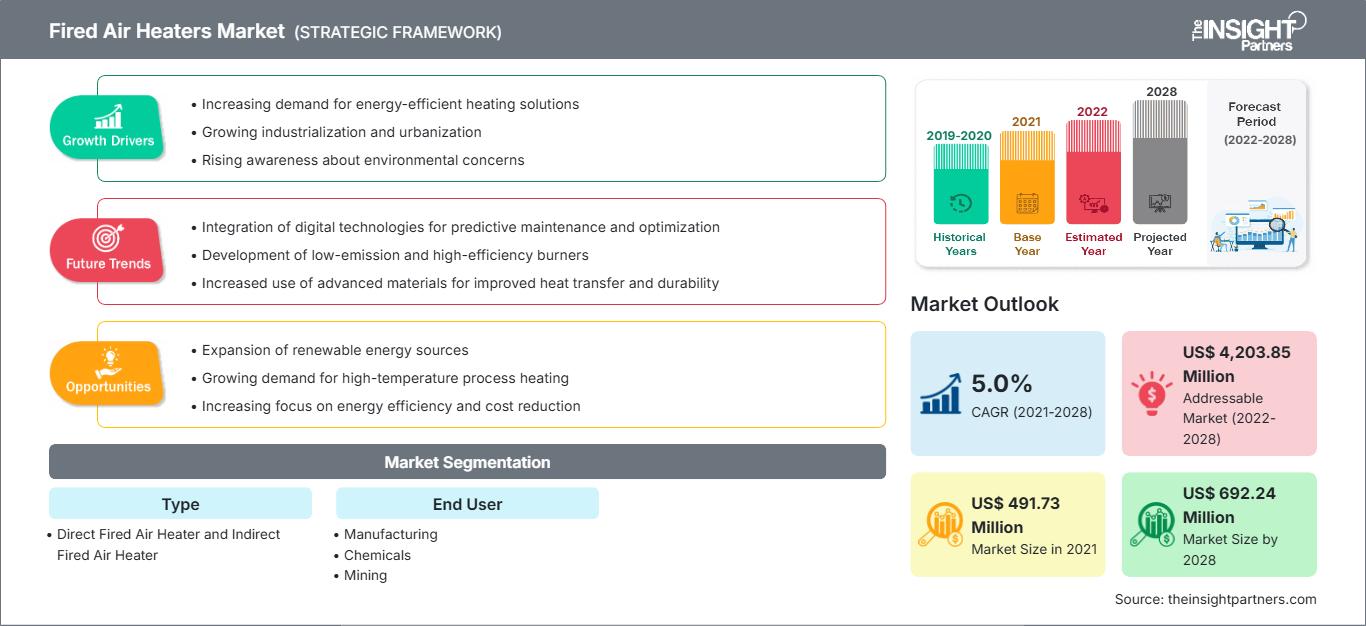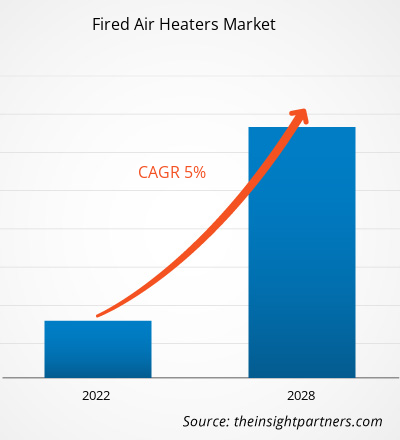소화식 공기 가열기 시장은 2021년 4억 9,173만 달러에서 2028년 6억 9,224만 달러로 성장할 것으로 예상되며, 2021년부터 2028년까지 연평균 성장률 5.0%로 성장할 것으로 예상됩니다.
신흥국의 산업용 난방 장비 수요 증가는 소화식 공기 가열기 시장의 주요 성장 동력입니다. 중국, 인도, 일본, 브라질과 같은 신흥 경제국 기업의 에너지 수요 증가가 소화식 공기 가열기 수요를 견인하고 있습니다. 또한, 짧은 시동 시간, 높은 효율, 높은 신뢰성 덕분에 제조, 발전 및 가공 분야에서 소화식 공기 가열기 수요가 증가했습니다. 또한, 발전 용량에 대한 투자 증가는 소화식 공기 가열기 시장 성장의 또 다른 원동력입니다. 수십 년간의 제품 생산 기술 발전으로 소화식 공기 가열기 수요는 지속적으로 크게 증가하고 있습니다.
소화식 공기 가열기는 가공 산업에서 기체 또는 액체를 특정 온도로 가열하는 데 일반적으로 사용됩니다. 또한, 연소식 공기 히터에 사물 인터넷(IoT)을 통합하면 연소식 공기 히터의 도입이 늘어나 예측 기간 동안 시장 성장이 촉진될 것입니다.
요구 사항에 맞게 이 보고서를 사용자 정의하십시오.
이 보고서의 일부, 국가 수준 분석, Excel 데이터 팩을 포함하여 모든 보고서에 대한 사용자 정의를 무료로 받을 수 있을 뿐만 아니라 스타트업 및 대학을 위한 훌륭한 제안 및 할인을 이용할 수 있습니다
연소식 공기 히터 시장: 전략적 통찰력

-
이 보고서의 주요 주요 시장 동향을 확인하세요.이 무료 샘플에는 시장 동향부터 추정 및 예측에 이르기까지 데이터 분석이 포함됩니다.
COVID-19 팬데믹이 화력 공기 히터 시장에 미치는 영향
COVID-19 팬데믹은 전 세계에 심각한 영향을 미쳤으며 여러 국가를 계속해서 파괴하고 있습니다. COVID-19 발생 이전까지 화력 공기 히터 산업은 생산량 측면에서 상당한 성장을 경험했습니다. 안타깝게도 COVID-19 발생으로 인해 전 세계 여러 산업에서 화력 공기 히터 수요가 급감하여 항공기 제조업체의 주문량이 크게 감소하고 생산량이 감소했습니다. 생산량 감소는 다양한 부품 제조업체와 관련 기술 사업에 부정적인 영향을 미쳤습니다. 더욱이 건설, 자동차, 광업과 같은 최종 사용자의 약화는 시장의 활력을 저하시켰습니다. 따라서 화력 공기 히터 시장 참여자들의 사업은 생산 불안정으로 심각한 타격을 입었습니다. COVID-19 바이러스가 확산되는 동안 건설 산업 전체는 미래를 예측할 자원이 부족한 채 마비되었습니다. 미국, 프랑스, 러시아, 중국의 여러 생산 시설은 정부의 봉쇄 및 사회적 거리두기 지침을 준수하기 위해 일시적으로 가동이 중단되었습니다. 건설 업체들은 신규 프로젝트 수요가 20~30% 감소했습니다. 또한, 진행 중인 건설 프로젝트의 중단으로 시장이 더욱 약화되었습니다. 이러한 요인은 연소식 공기 히터 시장에 부정적인 영향을 미쳤습니다.
연소식 공기 히터 시장 분석
산업용 난방 장비 수요 증가
보일러, 히트 펌프, 퍼니스는 화학, 식품, 건설, 광업 및 기타 산업에서 생산 공정을 수행하는 데 사용되는 산업용 난방 장비입니다. 보일러는 물이나 기타 액체를 가열하여 증기를 생성하고, 고압으로 분사하여 기계를 구동하는 밀폐 용기입니다. 또한, 히트 펌프는 열을 따뜻하거나 차가운 곳으로 전달하는 장치입니다. 퍼니스는 중앙 난방 시스템의 필수 구성 요소입니다. 아민 및 글리콜 재비기에서 부식성 황화수소와 이산화탄소 가스는 천연가스 및 원유 정제 파이프라인에 저장되거나 유입되기 전에 탄화수소 증기에서 제거되어야 합니다. 천연가스 증기와 마찬가지로 글리콜은 분배 전에 천연가스에서 수분을 제거하는 데 사용됩니다. 유지 보수 비용이 저렴하고 사용이 간편하기 때문에 이러한 유형의 가열기는 천연가스, 원유 및 가공 분야에서 사용됩니다. 화학 공정 분야에서는 연소 가열기가 공정 유체를 가열하고 증기를 생성하는 데 일반적으로 사용됩니다. 대부분의 경우, 연소 가열기는 공정 산업에서 가장 많은 에너지를 소비합니다. 이 연구에서는 수직 튜브가 있는 상자형 가열기를 사용하여 탄화수소 유체를 가열합니다. 용출 가열기는 독특하고 고유한 설계가 필요한 연소 공기 가열기의 특수 응용 분야로, 광업 분야에서 사용됩니다. 용출은 분석 및 유기화학에서 거의 항상 열을 가하여 용매로 세척하여 한 물질을 다른 물질에서 추출하는 과정입니다. 금과 같은 광물은 교환기를 사용하여 추출됩니다. 열교환기의 한쪽에서는 미네랄과 용매 용액이 순환하고, 다른 쪽에서는 열전달 유체(일반적으로 열 유체)가 분배됩니다. 식품 산업, 특히 감자, 스낵, 조리된 음식 등의 튀김류는 열전달 유체 히터를 통해 가열됩니다. 열전달 유체는 장비 내부에서 가열되어 순환하고, 그 열은 교환을 통해 위쪽에서 제품을 튀기는 기름으로 전달됩니다. 일부 설비는 채굴 용출 공정과 유사하게, 튀김유가 보일러를 직접 순환하여 연소 공기 히터로 사용되는 방식으로 설치되었습니다. 직접 연소 히터는 때때로 열전달 유체 히터 또는 석유화학 산업의 간접 히터로 사용됩니다. 화학 공장 및 정유 공장에서 직접 연소 히터의 유지보수 서비스가 원활하게 작동하고 예비 부품이 균일하다는 점이 이러한 도입의 주요 원인입니다. 열전달 유체 히터는 특정 기능의 장점으로 잘 알려져 있기 때문입니다. 따라서 다양한 산업용 난방 장비에 대한 수요 증가가 연소식 공기 히터 시장을 견인하고 있습니다.
유형별 시장 분석
연소식 공기 히터 시장은 유형에 따라 직접 연소식 공기 히터와 간접 연소식 공기 히터로 구분됩니다. 직접 연소식 공기 히터는 천연가스 또는 프로판 가스와 같은 적절한 공연비를 유지하여 산업 환경을 안전하게 난방할 수 있는 수단을 제공합니다. 가스는 직접 연소식 히터에서 버너로 직접 공급되고, 기류는 연소에 필요한 산소를 공급합니다. 가스는 버너 배플을 통해 공급되는 공기와 혼합됩니다. 버너는 기류와 함께, 그리고 기류와 평행하게 연소되도록 설계되었습니다. 연료의 약 100%가 열로 전환되므로 연료 소비량과 운영 비용이 절감됩니다.
연소식 공기 히터 시장The Insight Partners의 분석가들은 예측 기간 동안 가열식 공기 히터 시장에 영향을 미치는 지역별 동향과 요인을 면밀히 분석했습니다. 이 섹션에서는 북미, 유럽, 아시아 태평양, 중동 및 아프리카, 그리고 중남미 지역의 가열식 공기 히터 시장 부문 및 지역별 분포도 살펴봅니다.
가열식 공기 히터 시장 보고서 범위
| 보고서 속성 | 세부 |
|---|---|
| 시장 규모 2021 | US$ 491.73 Million |
| 시장규모별 2028 | US$ 692.24 Million |
| 글로벌 CAGR (2021 - 2028) | 5.0% |
| 이전 데이터 | 2019-2020 |
| 예측 기간 | 2022-2028 |
| 다루는 세그먼트 |
By 유형
|
| 포함된 지역 및 국가 |
북미
|
| 시장 선도 기업 및 주요 회사 프로필 |
|
가열식 공기 히터 시장 참여자 밀도: 비즈니스 역학에 미치는 영향 이해
소비자 선호도 변화, 기술 발전, 그리고 제품 이점에 대한 인식 제고 등의 요인으로 인해 최종 사용자 수요가 증가함에 따라, 화력 공기 히터 시장은 빠르게 성장하고 있습니다. 수요가 증가함에 따라 기업들은 제품 라인업을 확장하고, 소비자 니즈를 충족하기 위한 혁신을 추진하며, 새로운 트렌드를 적극 활용하고 있으며, 이는 시장 성장을 더욱 가속화하고 있습니다.

- 을 얻으세요 연소식 공기 히터 시장 주요 주요 플레이어 개요
소화식 공기 히터 시장에서 활동하는 업체들은 시장 내 입지를 유지하기 위해 인수, 합병 및 시장 이니셔티브와 같은 전략을 채택합니다. 주요 업체들의 몇 가지 개발 사례는 다음과 같습니다.
- 2018년, 고성능 휴대용 작업 현장 장비를 생산하는 80년 역사의 Allmand Bros. Inc.(Briggs & Stratton Corporation의 자회사)는 새로운 기술을 도입하여 생산 용량을 늘리고 출시 속도를 높이기 위해 네브래스카주 홀드리지에 있는 기존 시설을 확장했습니다.
- 2018년, 열매체유 히터 설계 및 제조 분야의 선두 기업인 Pirobloc은 미국에 자회사를 설립했습니다. Pirobloc USA는 이미 출시되었으며, 본격적인 운영을 시작했습니다.
전 세계 소화식 공기 히터 시장은 다음과 같이 세분화됩니다.
소화식 공기 히터 시장 - 유형별
- 직접 가열식 공기 히터
- 간접 가열식 공기 히터
가열식 공기 히터 시장 - 최종 사용자별
- 제조
- 화학
- 광산
- 창고
- 석유 및 가스
- 제약
- 기타
가열식 공기 히터 시장 - 지리별
- 북미
- 미국
- 캐나다
- 멕시코
- 유럽
- 독일
- 프랑스
- 이탈리아
- 영국
- 러시아
- 나머지 유럽
- 아시아 태평양(APAC)
- 호주
- 중국
- 인도
- 일본
- 대한민국
- 나머지 아시아 태평양
- 중동 및amp; 아프리카(MEA)
- 남아프리카공화국
- 사우디아라비아
- UAE
- 나머지 MEA
- 남아메리카(SAM)
- 브라질
- 아르헨티나
- 나머지 SAM
회사 프로필
- ALLMAND BROS., INC
- Exotherm Corporation
- Hastings HVAC, Inc.
- Pirobloc, SA
- SIGMA THERMAL, INC
- Stelter & Brinck, Ltd.
- Tamarack Industries
- Therm Dynamics
- Wacker Neuson SE
- Zeeco, Inc
- 과거 분석(2년), 기준 연도, CAGR을 포함한 예측(7년)
- PEST 및 SWOT 분석
- 시장 규모 가치/거래량 - 글로벌, 지역, 국가
- 산업 및 경쟁 환경
- Excel 데이터세트
최근 보고서
관련 보고서
사용 후기
구매 이유
- 정보에 기반한 의사 결정
- 시장 역학 이해
- 경쟁 분석
- 고객 인사이트
- 시장 예측
- 위험 완화
- 전략 기획
- 투자 타당성 분석
- 신흥 시장 파악
- 마케팅 전략 강화
- 운영 효율성 향상
- 규제 동향에 발맞춰 대응






















 무료 샘플 받기 - 연소식 공기 히터 시장
무료 샘플 받기 - 연소식 공기 히터 시장